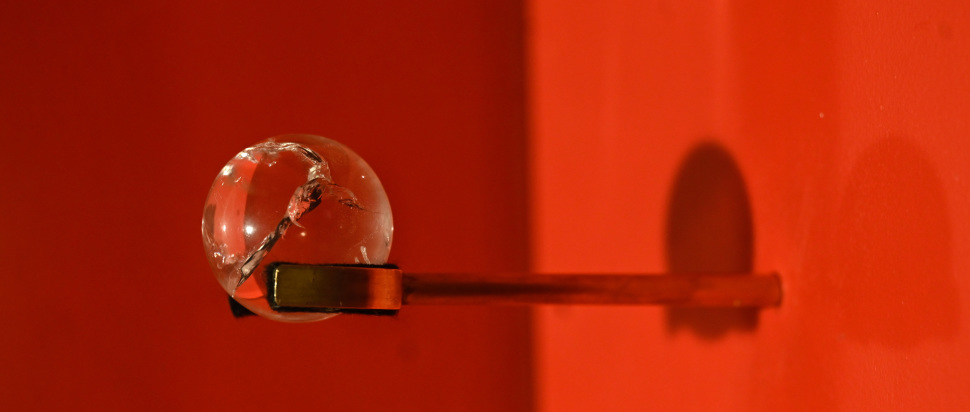Power Play: Inside Perth Museum's new Macbeth exhibition
From historical figure to blockbuster anti-hero, Macbeth: An Exhibition at Perth Museum traces the many reincarnations of a Scottish king

A stone’s throw from Birnam Wood and Dunsinane Hill, Perth Museum became the permanent home of the Stone of Destiny in 2024. This ancient slab of red sandstone was used to crown Scottish monarchs until the 13th century. According to curator JP Reid, while its symbolic significance might seem arbitrary, the stone has become a “locus for political ideal and identity politics.” In its repeated journeys across the Scottish border to find its rightful owner, the sandstone has accrued power. Its return to Scotland prompted Perth Museum to examine how power is enacted, a thread that now runs through its public exhibitions programme.
Enter Macbeth – one of 42 kings said to have been crowned on the Stone of Destiny. While the historical record of the 11th-century king remains fragmentary, William Shakespeare mythologised the medieval figure into a household name. Themes of power, legitimacy, and tyranny abound in Macbeth, and the play’s enduring and captivating cultural resonance, along with its historical roots, has made it the focal point of Perth Museum’s latest exhibition.
Macbeth: An Exhibition brings together a diverse selection of rarely-seen material relating to both the historical king and the fictional character. It begins in 1040, with the Clach na Bratach stone once owned by Clan Donnachaidh. Clan Donnachaidh can be traced back to King Duncan I, who was killed during the Battle of Pitgaveny, resulting in victory for Macbeth. Also on display is an 11th century sword, typical of those used throughout Europe during this time period. The sword is a remarkable piece, surviving from an age of warring kingdoms, family blood feuds and Viking settlers. This is the first time it will be on public display.
The exhibition moves into the uncertain world in which Shakespeare fictionalised his Macbeth: the reign of James VI and I, which was dominated by a paranoia about witchcraft that had severe, fatalistic consequences, resulting in the deaths of approximately 2,500 people. Written texts on display capture the fierce debate in early modern Britain over witchcraft’s legitimacy. Reginald Scot’s The Discoverie of Witchcraft (1584) argues against the belief in witchcraft, while the first edition of Dæmonologie (1597) is a devastating rebuttal that endorses the persecution of witches. Authored by James VI and I himself, Dæmonologie acts as a guide to identifying and punishing witches. “This person in charge was profoundly delusional,” stresses Reid, “and he had power at his disposal to exercise that paranoia in a way that impacts the lives of thousands upon thousands of people.”

Andrew Wallace takes a closer look at the crown worn by actor Michael Fassbender in the 2015 film Macbeth. Photo by Julie Howden, courtesy of Culture Perth & Kinross
With an emphasis on written material gathered from northeast Scotland, the exhibition also features Aberdeen Council’s itemised list of materials Aberdeen City & Aberdeenshire Archives’ itemised list of materials from the 1500s such as chains and firewood, for prosecuting witches. Elsewhere, testimonies from the accused in Perth and Kinross reveal desperate attempts to justify their actions and avoid execution. As Reid notes, the minutes from court sessions show how confessions grow increasingly unstable under physical or mental torture. Perth Museum illuminates the importance of showcasing these literary sources, as very little material evidence remains from the lives of the accused, given they were starved of all forms of dignity.
By contrast, Perth Museum platforms contemporary creatives who continue to reshape the Shakespearean character. Shedding light on the transformation of Macbeth according to drastic societal shifts, London-based artist Charlotte Rose applies Machiavellian branding techniques once employed by cigarette companies. Her oil painting A Dagger of the Mind (2023) combines the unmistakable Marlboro branding with Shakespearean tragedy to expose the tactics of commodification. In a capitalist society saturated by visual codes, Macbeth is packaged up like a global brand. Further exciting contemporary loans include costumes and props from the 2015 epic historical drama Macbeth, directed by Justin Kurzel. There’s even an opportunity to get up close to the throne that Michael Fassbender sat on while starring as our titular anti-hero.
With great curatorial care, Macbeth: An Exhibition skilfully moves between extremities, encompassing the horrific realities of witch hunts to the spectacle of 21st century blockbusters. Macbeth's multiple afterlives are brought to light: historical figure, tyrant, and ultimately, commodity.
Macbeth: An Exhibition is open until 31 August. Tickets available individually or as part of a discounted combination ticket with GLASS, Perth Art Gallery; visit perthmuseum.co.uk for more information
